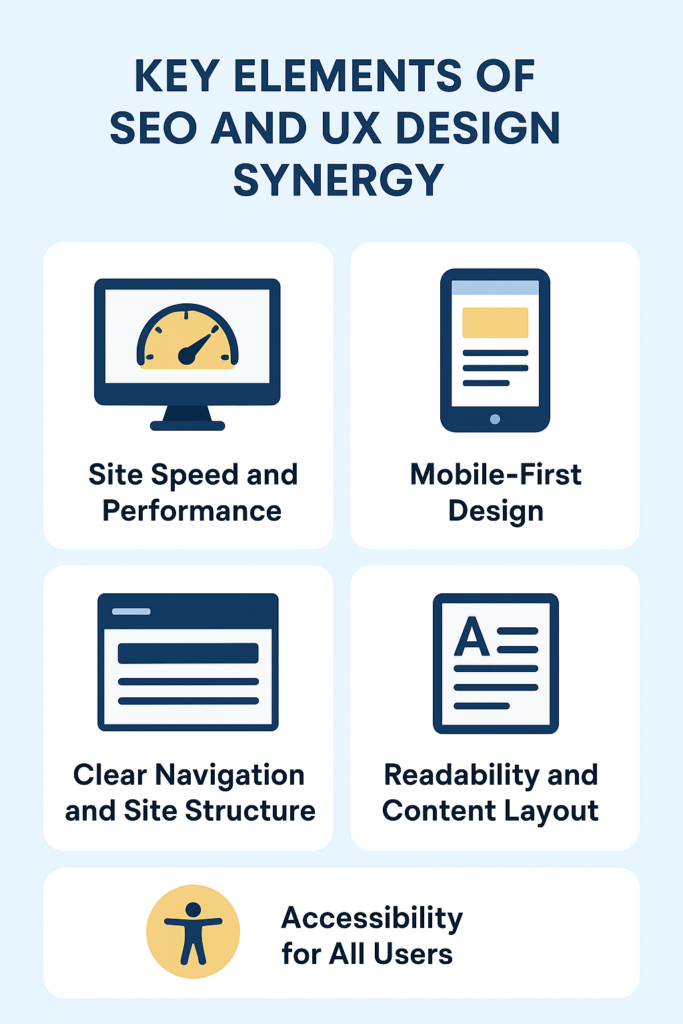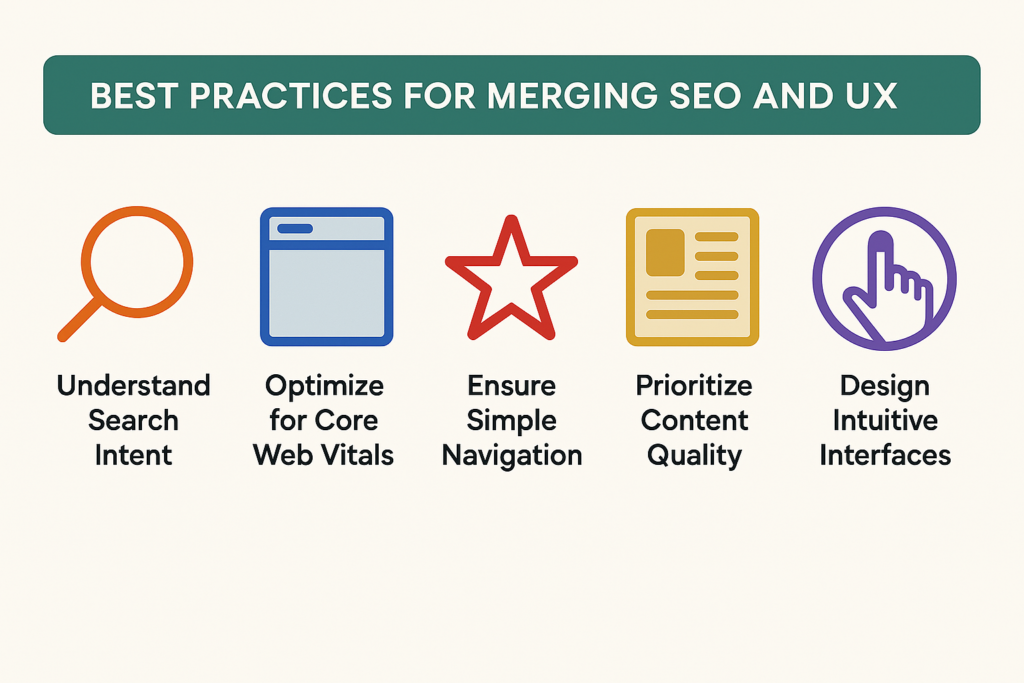
How to Audit SEO and UX Design Synergy on Your Site
Discover how to audit SEO and UX design synergy on your site to boost performance, improve user satisfaction, and drive more conversions. Learn practical tips to align SEO strategies with UX design for long-term success.
Table of Contents
Introduction
Ever clicked on a site that loaded slowly, had messy navigation, or bombarded you with popups? Chances are, you left within seconds. That’s exactly where SEO and UX design synergy comes into play. While UX makes sure visitors stay, interact, and convert, SEO brings visitors to your website. The other cannot fully succeed without the first.
Understanding SEO and UX Design Synergy
About the SEO and UX Design Synergy
SEO is about visibility—keywords, backlinks, technical structure. UX is about experience—design, usability, and accessibility. When combined, they create a smooth, optimized digital experience that satisfies both Google and users.
Think of it this way: SEO is the roadmap that guides people to your store, while UX is the store layout that makes people want to browse and buy.
The Relationship Between SEO and UX
Google has shifted focus from keyword stuffing to user signals like page speed, mobile usability, and engagement. A fast, easy-to-use website not only makes people happy but also helps you rank higher.
In fact, websites that prioritize SEO and UX design synergy often see better dwell times, lower bounce rates, and more conversions—metrics Google loves.
Key Elements of SEO and UX Design Synergy
Site Speed and Performance
Nobody waits for a slow website. Delays in page load time can directly hurt your conversion rates. Optimizing Core Web Vitals is a must.
Mobile-First Design
With most searches happening on mobile, your site must adapt seamlessly. Responsive design is no longer optional.
Clear Navigation and Site Structure
Visitors should reach any page within three clicks. A logical flow improves both crawlability and user satisfaction.
Readability and Content Layout
Walls of text push readers away. Use headings, bullet points, and visuals to keep things digestible.
Accessibility for All Users
SEO doesn’t end with keywords. Making your site accessible for screen readers and differently-abled users builds trust and expands reach.
Step-by-Step Audit of SEO and UX Synergy
Step 1: Technical SEO Audit
Check crawlability, fix broken links, and optimize loading speed. Tools like Screaming Frog can help.
Step 2: Content Audit
Balance keyword optimization with natural readability. Ask yourself—does this content solve user intent?
Step 3: UX Journey Mapping
Track how users move through your site. Are they dropping off too early? Heatmaps reveal friction points.
Step 4: On-Page Engagement Metrics
Analyze bounce rates, dwell times, and click-through rates to see where users lose interest.
Step 5: Mobile and Responsive Testing
Test your site across multiple devices. A beautiful desktop site is useless if mobile visitors bounce.
Tools for Conducting an SEO + UX Audit
- Google Analytics & GA4: For traffic and engagement insights
- Google Search Console: For indexing and keyword data
- Hotjar/Crazy Egg: Heatmaps and recordings
- PageSpeed Insights/Lighthouse: Core Web Vitals performance
Common Mistakes in SEO and UX Audits
- Over-prioritizing keywords at the cost of readability
- Designing only for aesthetics without SEO alignment
- Ignoring accessibility guidelines
Best Practices for Merging SEO and UX
- Always design content for search intent
- Keep layouts clean, scannable, and engaging
- Ensure design consistency across devices and pages
Advanced Strategies
- Use personalization and AI-driven content recommendations
- Implement schema markup for better SERP visibility
- Make sure your content satisfies conversational searches by optimizing for voice search.
Measuring the Results of SEO and UX Synergy
Track keyword rankings, conversion rates, and engagement metrics. Over time, you’ll notice stronger organic visibility and deeper customer trust.
Future of SEO and UX Collaboration
Expect Google to reward user-first design even more. With AI, personalization, and emerging search methods, SEO and UX design synergy will only grow in importance.
Conclusion
An effective website isn’t just about ranking high or looking good—it’s about merging SEO and UX into a seamless system. By auditing and improving their synergy, you’re not just impressing Google—you’re delighting real people who matter most.
Frequently Asked Questions
SEO focuses on visibility, while UX ensures usability and engagement. Together, they create a complete user journey.
Better UX leads to longer dwell times, lower bounce rates, and higher engagement—all signals Google rewards.
Google Analytics, Search Console, Hotjar, and Lighthouse are essentials.
Not entirely. UX keeps users engaged, but SEO brings them in. Both are needed for success.
At least twice a year, or whenever you launch major updates.
Table of Contents
Popular Posts
-
 Affordable Technical SEO Audit for Small Business: A Complete Guide26 Jun 2025 Blog
Affordable Technical SEO Audit for Small Business: A Complete Guide26 Jun 2025 Blog -
 How to Get an Affordable Technical SEO Audit for Small Business27 Jun 2025 Blog
How to Get an Affordable Technical SEO Audit for Small Business27 Jun 2025 Blog -
 The Ultimate Local SEO Audit Checklist for Startups28 Jun 2025 Blog
The Ultimate Local SEO Audit Checklist for Startups28 Jun 2025 Blog -
 Local SEO Audit Checklist for Startups: A Beginner’s Guide28 Jun 2025 Blog
Local SEO Audit Checklist for Startups: A Beginner’s Guide28 Jun 2025 Blog -
 Top On-Page SEO Audit Steps for Service Websites Every Business Should Know29 Jun 2025 Blog
Top On-Page SEO Audit Steps for Service Websites Every Business Should Know29 Jun 2025 Blog -
 Technical SEO for WordPress: The Ultimate Beginner’s Guide01 Jul 2025 Blog
Technical SEO for WordPress: The Ultimate Beginner’s Guide01 Jul 2025 Blog -
 The Impact of On-Page SEO Audit Steps for Service Websites on UX01 Jul 2025 Blog
The Impact of On-Page SEO Audit Steps for Service Websites on UX01 Jul 2025 Blog -
 Technical Mobile SEO Audit Tips for Developers02 Jul 2025 Blog
Technical Mobile SEO Audit Tips for Developers02 Jul 2025 Blog -
 Complete SEO Backlink Audit Guide for Better Google Rankings03 Jul 2025 Blog
Complete SEO Backlink Audit Guide for Better Google Rankings03 Jul 2025 Blog -
 Boost Your Rankings with Technical SEO for WordPress01 Jul 2025 Blog
Boost Your Rankings with Technical SEO for WordPress01 Jul 2025 Blog







